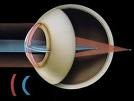
Astigmatism is a refractive error where people are unable to see objects clearly from a distance or up close. Astigmatism may occur in varying degrees in each eye and can accompany myopia or hyperopia. A minor degree of astigmatism is usually not noticeable or comes with slight blurriness but a major degree of astigmatism causes blurriness for objects at any distance.
Astigmatism Treatments
People with Astigmatism have blurred vision of varying degrees. Treatment for astigmatism includes eyeglasses, special contacts, and certain refractive surgeries.
To correct astigmatism contacts called toric, can be specially designed for people with astigmatism. Minor degrees of astigmatism can be corrected with soft toric lenses. High degrees of astigmatism are better corrected with eyeglasses or RGP toric contact lenses. Toric contact lenses are more expensive than normal contacts because of the extra correction provided on them. Surgical treatments for astigmatism include LASIK Eye Surgery (Laser in-situ keratomileusis) and CK (Conductive keratoplasty) for people over 40, Astigmatic Keratotomy (AK), and Orthokeratology. LASIK reshapes the cornea by removing tissue. In Astigmatic Keratotomy, an older treatment, an eye care surgeon places incisions in the periphery of the cornea to change its shape for better vision. Orthokeratology, or Ortho-K, uses RGP contact lenses to gradually reshape the cornea. The reshaping of the cornea is not permanent however and the special contact lenses will still be worn a few hours a day to keep the new shape. Only minor degrees of astigmatism are best treated with this method. The correction of astigmatism is constantly being researched. New advances in materials and technology will greatly help people with astigmatism see clearly again.
Couresy: Eye Care Source
